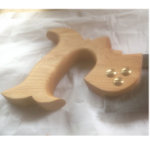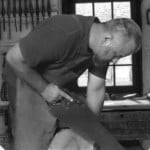Smoother
Welcome! / Forums / General Woodworking Discussions / Projects / Smoother
- This topic has 8 replies, 4 voices, and was last updated 8 years, 8 months ago by
emilio.remogna.
-
AuthorPosts
-

 20 July 2015 at 9:20 pm #128663
20 July 2015 at 9:20 pm #128663Looks pretty cool, Mark. I’ve been wanting to make something like this. I think my next project is to make a small curved-sole plane for hollowing chair seats.
Can you tell me the iron width? Also, I’ve seen this design before with the wooden dowel holding the wedge against the blade. Did you figure out the location of the dowel through drawings or was it a bit of trial and error?
 20 July 2015 at 10:08 pm #128666
20 July 2015 at 10:08 pm #128666I too want to make some wooden bodied planes especially molding planes. I think the iron you have is a 1 3/4″. btw what is the correct spelling for molding planes is it that or this “moulding”
 20 July 2015 at 11:43 pm #128668
20 July 2015 at 11:43 pm #128668Yes it is a 1 3/4″ double iron
Mouldings planes I would imagine quite tricky to make as you would need moulding planes to make them at least by hand.
The other thing about moulding planes is they have springing lines on them and you hold them at an angle until the spring line on front of plane is vertical. The main reasons for the angle you would be working more one the corner of bord and work down easier on profil of plane. Also is so that the iron and body of plane could be smaller.
Hollows and rounds on the other hand are normally straight and held in upright position but I believe you can get them on the skew as well. 20 July 2015 at 11:49 pm #128669
20 July 2015 at 11:49 pm #128669Yes another poster mentioned that and so did Bob from the Logan cabinet shop, I really would like to start making these planes but I also need floats to do it which I can’t afford at the moment. One approach I could take with the need for floats is by working in halves. I have European Beech available do you think that is a good timber for these planes.
 21 July 2015 at 12:23 am #128671
21 July 2015 at 12:23 am #128671@nobby1967 – Mark, I’m not certain what is meant by a “double iron”. Was that when the manufacturer laminated two pieces to make a single iron?
@salko – Salko, beech is a very traditional wood for moulding planes. And quartersawn beech was the wood of choice. I made a post a couple months ago about how I made some hollow and round planes out of alder, laminating parts so I didn’t have to use floats. It worked fine, but I’ve not yet really put them to a tough test.Oh, and not sure if you were joking, but “Moulding” is the English spelling and “Molding” is American. Although I’m American, I just like the English spelling better – it’s kind of “old-timey” for me.
 21 July 2015 at 12:45 am #128672
21 July 2015 at 12:45 am #128672Thanks Matt for that spelling clarification as I type certain words are coming up as an error even though I have set it to British English as it’s the same as Australian.
You mentioned beech but the beech that you used is different to the European Beech I’ve got. I have to look up the hardness difference between the two. I was reading about Clark & Williams unfortunately to my knowledge they don’t make planes anymore but they had a constant struggle in getting the right materials to make them. I really need to make many profiles moulding planes and hollow and rounds as antique ones are just too expensive to buy anymore. I do have an Emir no.5 jack I bought last week for $20 at a garage sale which I use as a scrub plane and it is made from European Beech but I wouldn’t consider it a premium tool just by the construction of it but it does work effortlessly which is why I would like to make these planes out of what I already have in stock.
I will do a search for your post to see how you did or maybe you could save me the trouble and just give me the link.
 21 July 2015 at 6:37 am #128680
21 July 2015 at 6:37 am #128680The old term for double iron is when the iron/blade and cap iron/ chip breaker are together.
Most wooden planes here in UK were made of beech.
I have a few and all are beech.
Philly planes makes a pair of hollows and rounds for about £220 so not cheap. -
AuthorPosts
- You must be logged in to reply to this topic.
